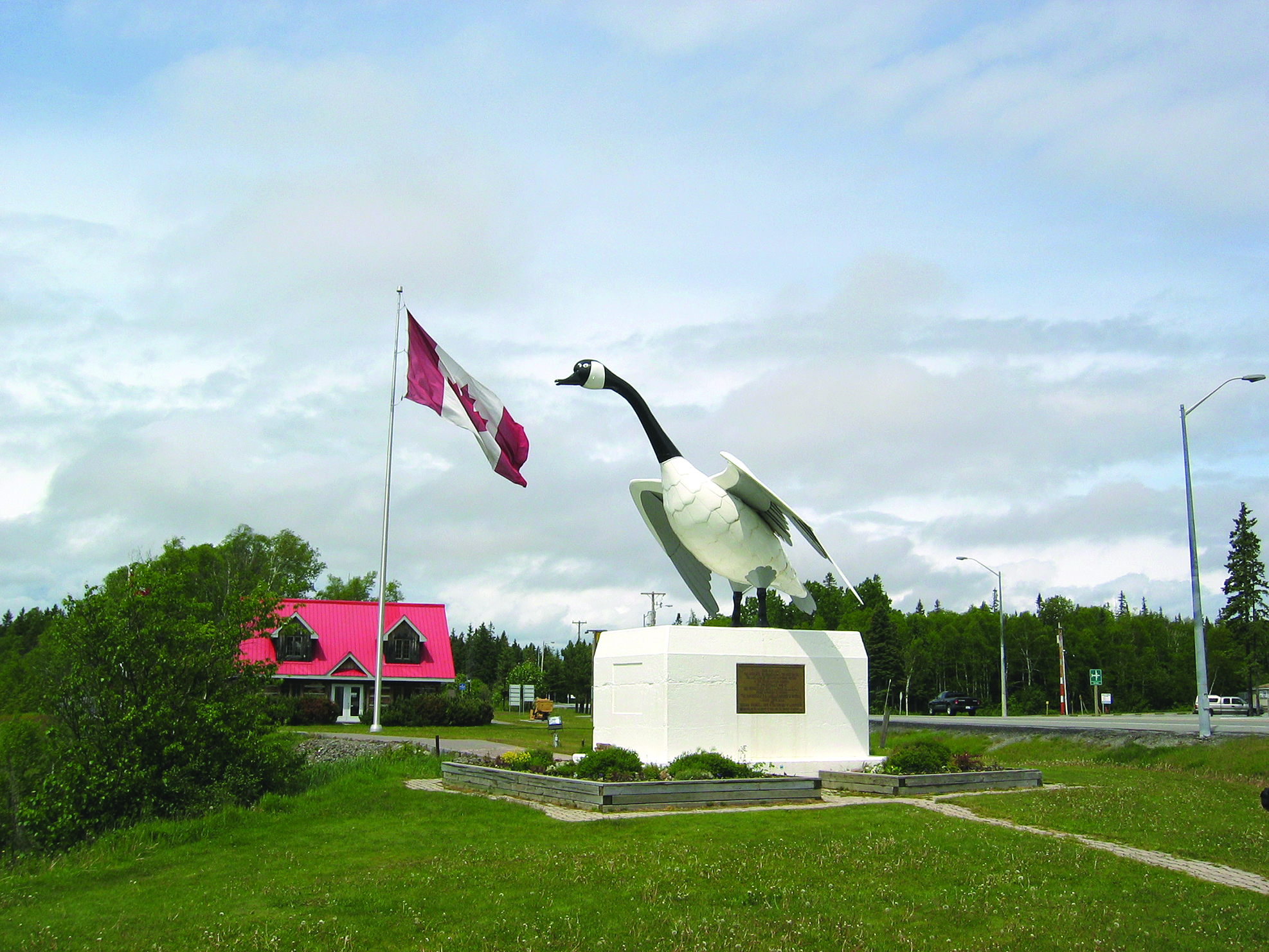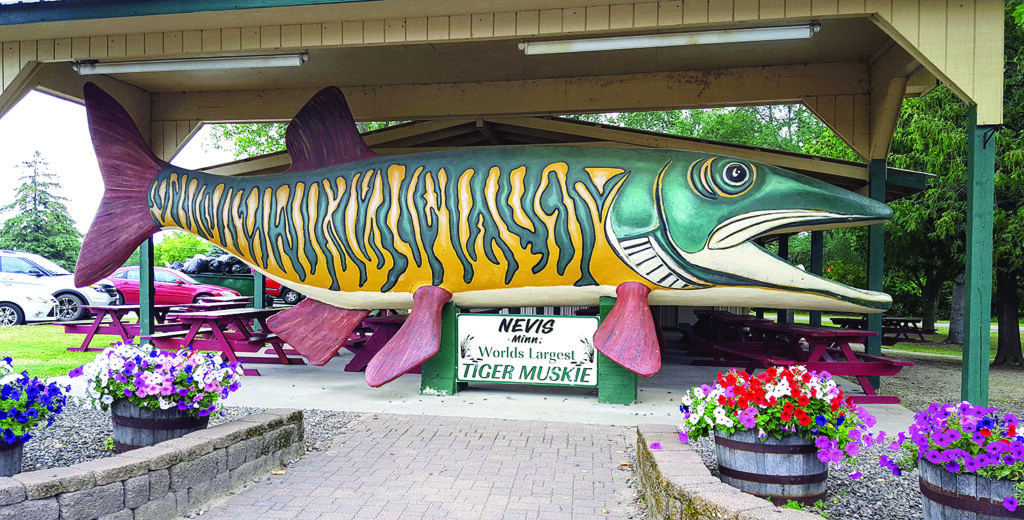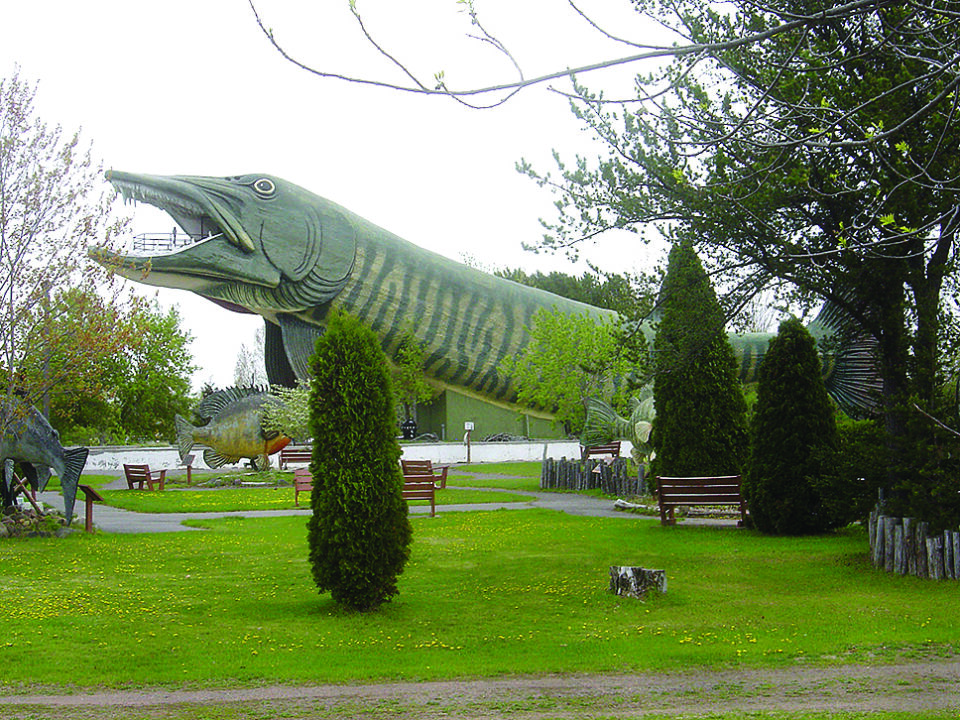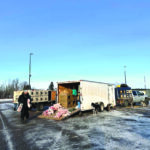A recent article in a national publication about the “World’s Largest Statues” raised the question whether there are any such statues in the Northern Wilds region. Surprisingly, yes, there’s an eclectic mix of these large statues.
The title of “World’s Largest Muskie” is claimed by Hayward in northwest Wisconsin. Constructed of concrete, steel, and fibreglass, and sculpted into a 143-foot jumping muskie, the statue is the featured landmark at the Fresh Water Fishing Hall of Fame, a multi-acre museum complex. According to their website, the museum has over 300 mounted fresh fish, 1,000 vintage outboard motors, and 50,000 vintage and historical lures.
Across the U.S.-Canada border in Kenora, Ontario, “Canada’s Largest Fish Statue” also features a leaping muskie. Nicknamed Husky the Muskie, the 40-foot-tall outdoor sculpture was originally constructed of steel, 36 sheets of plywood, and 3,500 bolts in 1967 and has been restored a few times since then.
Other fish statues claiming “World’s Largest” in Minnesota is a 30.5-foot Tiger Muskie in Nevis; a 15-foot Northern Pike in Erskine; a Lutefish (Lou T. Fisk) in Madison (Lutefish Capital of the World), and Willie the Walleye in Bemidji.

For 45 years (1960-2005), Thunder Bay was home to the “World’s Largest Curling Stone.” Made of solid concrete, the 7-foot-tall and 6-foot-diameter stone was manufactured by the local Canadian Car plant for the 1960 Brier (curling championship) and placed at the arena entrance at Fort William Gardens. Alas, in 2005 Thunder Bay lost the title to Arborg, Manitoba, when the small town created a curling rock weighing 3,000 pounds made of steel, foam, and fibreglass that was 13.78 feet across and 6 feet 10 inches tall. Thunder Bay is now home to the “World’s Second Largest Curling Stone.”
About a day’s drive east of Thunder Bay to Wawa is the famous “World’s Largest Canada Goose,” nicknamed “Grady,” and one of the most photographed landmarks in North America. Made of steel and standing 28 feet tall and 22 feet long with a wingspan of 20 feet, Grady even appears in a children’s book read across the world, Wawa Goose Meeting at Fort Friendship.
Yet, it is the United States statue of a Canada goose in Sumner, Missouri, that has the title, “World’s Greatest Goose.” Nicknamed “Maxie,” it has a height of 40 feet with a wingspan of 65 feet and poised on a building. Why Sumner? Well, the town claims to be the “Wild Goose Capital of the World.”
With the loon being Minnesota’s state bird since 1961, it’s befitting that it has two giant loon statues. One is the 20-foot-tall “World’s Largest Loon” overlooking Long Lake in Vergas. And over in Virginia, floating on Silver Lake, is the 20-foot-long “World’s Largest Floating Loon,” constructed of fibreglass over a metal frame and tethered by a long cable to the lake’s bottom. It is lifted out for storage during winter.
Other bird statues with “World’s Largest” titles in Minnesota is the 43-foot-high crow in Belgrade; 20-foot-tall turkey in Frazee; and the 13-foot-tall prairie chicken in Rothsay.
Two animal statues with “World’s Largest” status in Minnesota are the river otter nicknamed “Otto” in Fergus, and the pelican nicknamed “Pete” in Pelican Rapids.

In Dryden, Ontario, there’s the famous 18-foot-tall Max the Moose, the town’s official mascot, standing next to the tourist information centre on the Trans-Canada Highway. Weighing 9 tons, Max was built in 1962 of mesh, steel rods, concrete, and a layer of lacquer.
Other eclectic “World’s Largest” titles in Minnesota go to: Paul Bunyan statue in Akeley; Corn Cob statue in Olivia; Viking statue in Alexandria; Hockey Stick and Puck in Eveleth; Darwin’s Ball of Twine Made by One Man; Peace Pipe in Pipestone, and in North St. Paul, there’s the 44-foot-tall “World’s Largest Stucco Snowman” built using 20 tons of concrete stucco
In northwestern Ontario (NWO), the town of Beardmore claims to be the “Snow Capital of the World” and is home to the “World’s Largest Snowman.” Made of white wood, the all-year smiling 35-foot-tall snowman in summer wears sunglasses while holding a fishing rod and in winter, changes into a scarf and curling broom.
NWO also has some quirky large statues that don’t carry the “world’s largest” titles. Like Kenora’s bright yellow and black “Volkswagen Spider” landmark where an old Volkswagen sits atop spider legs made of pipes and an oil drum for a top hat. Hamlet of Upsala has a “Giant Mosquito” on a pole carrying off a man. At Vermilion Bay, there’s the famous roadside 20-foot sasquatch, made of cement and iron, hitchhiking along the Trans-Canada Highway.
Each giant statue is a unique creation with its own history and story, and they are great for exploring on road trips.




